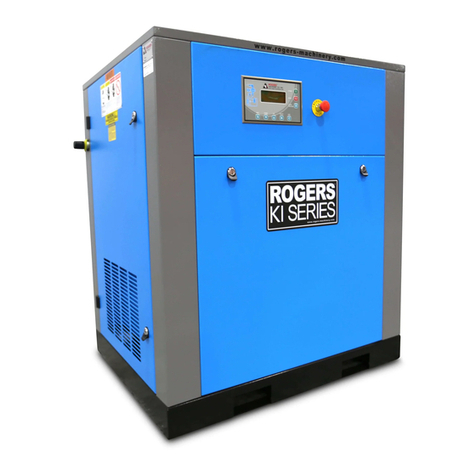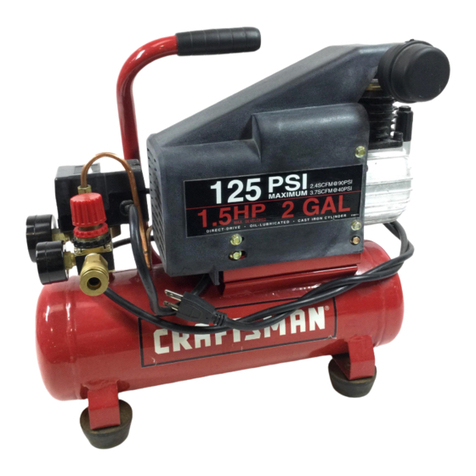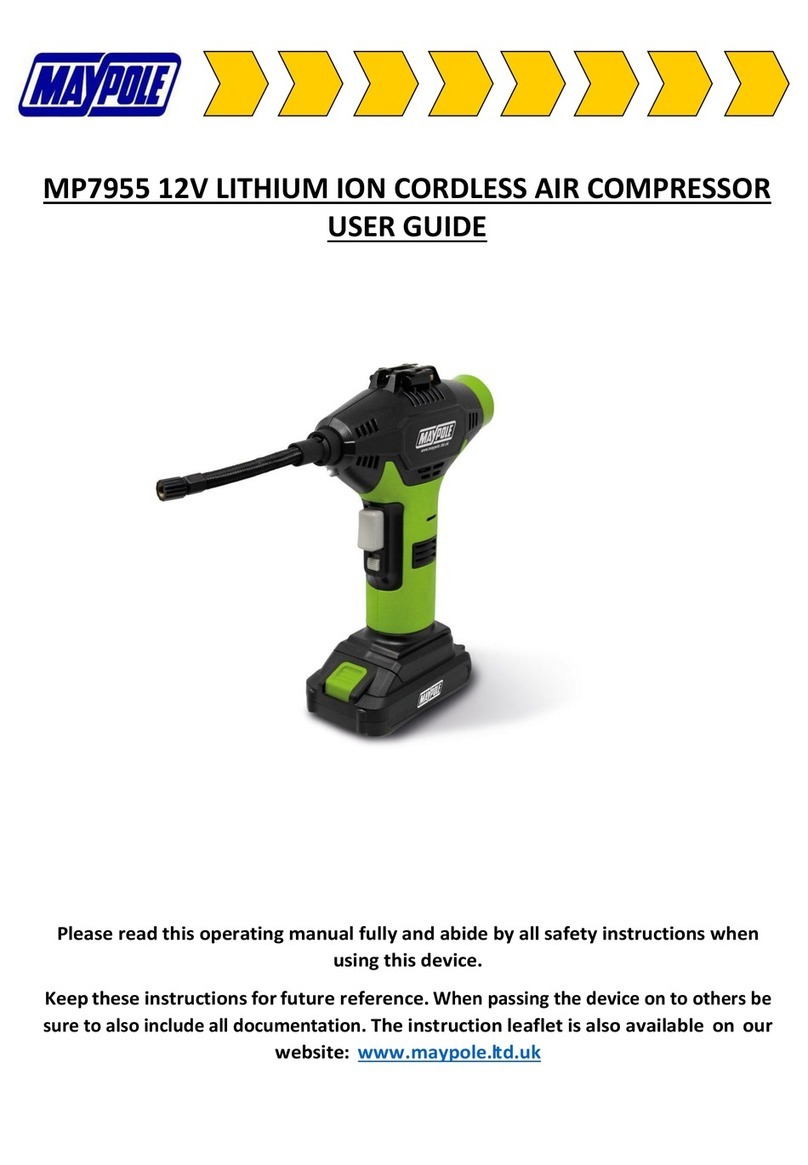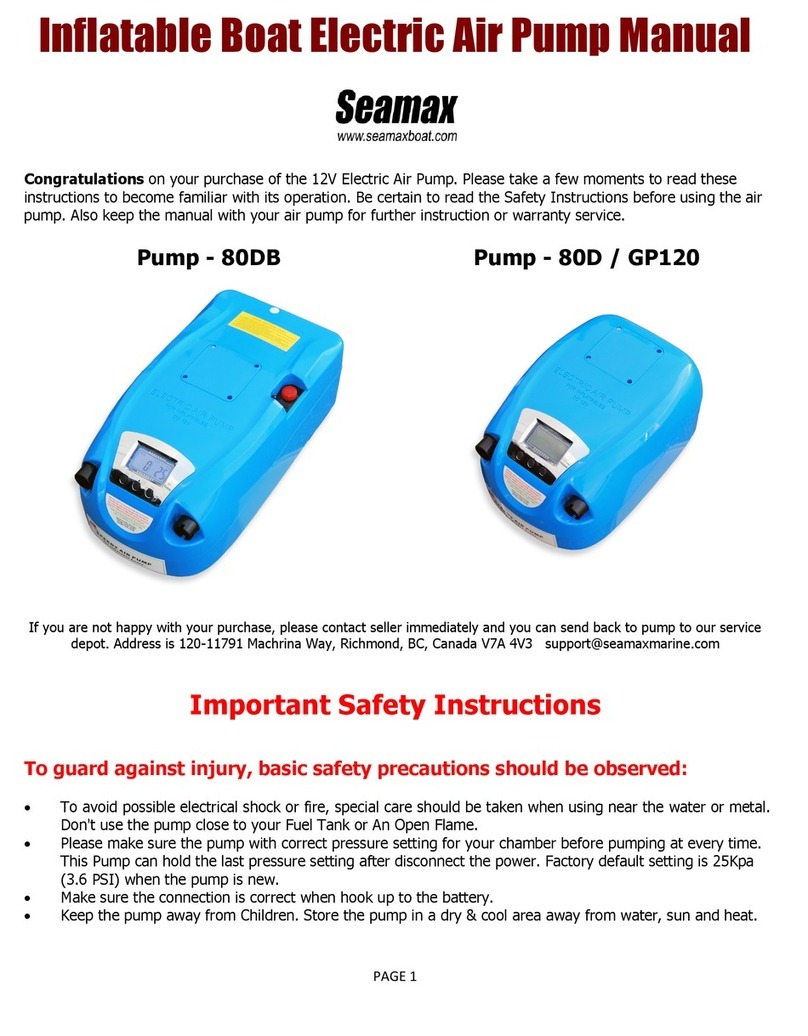Rogers KNW Series User manual

C:\Users\acg\AppData\Local\Microsoft\Windows\INetCache\Content.Outlook\QUQH0O0M\GPKD-
1550-H CAT Diesel Instruction Manual.doc APRIL2020
AIR-COOLED
ROTARY SCREW
AIR COMPRESSORS
OIL-FREE TWO-STAGE
MODEL
GPKD-1550-H
SERIAL
1806119004 – 1806119033
INSTRUCTION MANUAL
GPKD-1550-H
CATERPILLAR C18 TIER 4 FINAL – 1550 CFM
KOBELCO is the international trademark found on all products of Kobe Steel, Ltd.
The information in this manual is
current as of its publication date
and applies to compressor serial
numbers 1806119004 through
1806119033.

2
THIS PAGE
LEFT BLANK

3
SAFETY PRECAUTIONS
Safety notices, marked with this symbol, are used in this
publication to emphasize that a hazardous condition that
could cause personal injury and/or damage to the
equipment exists.
1. Read and understand the contents of this manual before
installing, operating or maintaining the compressor.
2. Electricity and compressed air are dangerous. Prior to performing
maintenance or service work, make absolutely sure that the
electrical supply is disconnected and locked out, the air discharge
service valve is closed and locked out (use Grainger 45MZ63 or
similar), and the compressor is relieved of all internal pressure.
3. Compressed air from this unit must not be used for breathing or
food processing, unless additional filtration and monitoring is
provided that meets the requirements of OSHA 29 CFR 1910 or FDA
21 CFR 178.3570.
4. Do not allow flammable, toxic or corrosive gases to enter the air
inlet system or electrical devices.
5. Never attempt to work on compressor or remove guards, panels,
covers, shields, etc. while the compressor is in operation.
6. Periodically confirm that all safety and alarm devices are
operating properly.
7. Do not override any safety or alarm device.
8. Make certain all associated pipe and equipment beyond this
compressor is compatible with maximum pressures and
temperatures to be encountered during normal and adverse
operation. Do not use plastic pipe in the compressed air system.
9. Keep doors closed during normal operation. The noise level
inside cabinet exceeds 90 decibels (dbA) and the operating
temperature of some components is enough to burn the skin.
10. Never assume it is safe to work on the compressor because it is
not operating. Many installations have automatic start/stop controls,
and the compressor may start at any time.

4
Instruction Manual
ROGERS KNW SERIES OIL-FREE
ROTARY SCREW AIR COMPRESSORS
MODEL: GPKD-1550-H
NOTE: A companion publication, “Description of Operations” (e.g. K2A075A) for the
HMI/PLC programs, contains detailed instructions on HMI operation and
compressor controls. A separate publication from Caterpillar “SEBU9106-14”
details the operation and maintenance of the C15 and C18 Diesel engine.
Revisions
Revision
Author
Date
Description
0
SGB
05-Jun-19
Convert from 690001M.3
KIMA02H to Diesel
1
SGB
23-Apr-19
Update from R&M Revision to H Revision
1. General Description ................................6
1.1. Compressor...............................................6
1.2. Compressed Air Flow................................7
1.3. Cooling Air Flow ........................................8
1.4. Oil Flow for Lubrication..............................9
1.5. Capacity Control System.........................10
1.6.Monitoring and Limiting Devices .............12
1.7. Alerts and Alarms....................................13
1.8. Component Locations .............................14
2. Installation..............................................23
2.1. Inspection................................................23
2.2. Handling ..................................................23
2.3. Foundation ..............................................23
2.4. Location...................................................24
2.5. Cooling Air...............................................24
2.6. Compressor Air Outlet Piping..................24
2.7. Air Receiver.............................................26
2.8. Wiring ......................................................27
3. Start-Up...................................................28
3.1. Pre-start Checks......................................28
3.2. Initial Start-up..........................................30
4. Operating Instructions..........................30
4.1. Starting the Compressor .........................30
4.2. Stopping the Compressor .......................31
4.1. Automatic Stop........................................31
5. Electrical Controls.................................32
5.1. Compressor Control Panel......................32
HMI Maintenance............................................33
5.2. Programmable Logic Controller.............. 33
6. Maintenance........................................... 33
6.1. Daily........................................................ 34
6.2. Weekly .................................................... 34
6.3. Every 250 Service Hours........................ 35
6.4. Monthly.................................................... 35
6.5. Every 500 Service Hours or 3 Months.... 35
6.6. Every 2000 Service Hours...................... 35
6.7. Yearly...................................................... 35
6.8. Every 2500 Service Hours ...................... 36
6.9. Every 3000 Service Hours or 3 Years .... 36
6.10. Every 4000 Service Hours...................... 36
6.11. Every 5000 Service Hours ...................... 37
6.12. Every 6000 Service Hours or 3 Years .... 37
6.13. Every 10,000 Service Hours................... 37
6.14. Every 12,000 Service Hours or 6 Years . 37
6.15. Lubrication Oil......................................... 37
6.16. Filters ...................................................... 38
Inlet Air Filter (Compressor and Engine)........ 38
Compressor Oil Filter...................................... 38
Sump Breather ............................................... 39
Control Air Filter.............................................. 39
Engine Oil Filter.............................................. 39
DEF Manifold Filter......................................... 39
Diesel Exhaust Fluid Filter.............................. 39
Fumes Disposal Filter Element....................... 39

5
Fuel System Primary/Secondary Filter (Water
Separator) Element.........................................39
7. Standby and Stored Units.....................39
7.1. Standby Units..........................................39
7.2. Short-term Storage..................................39
7.3. Long-term Storage ..................................40
8. Typical Operating Conditions ..............41
Operating Temperatures and Pressures.................41
9. Troubleshooting ....................................43
9.1. Compressor.............................................43
9.2. PLC (See Description of Operations
Manual for additional details)...................................46

6
1. General Description
1.1. Compressor
The Rogers KNW Series air compressor is a heavy duty, two-stage, rotary screw
design that provides completely oil-free compressed air. Oil-free compressed air is
guaranteed by a unique seal arrangement that separates the bearings and gear
chambers from the compression section of each stage. The dual vent seal design
ensures that no oil or its vapor can contaminate air that is being compressed.
The two-stage design provides higher output pressures at a lower operating temperature
than would be available from a single-stage design. Both compressor stages are
mounted on a heavy-duty cast-iron gear case for permanent alignment. The stages are
driven through precision machined gears, selected for optimum operating speed to
maximize efficiency and reduce rotor thrust. Timing gears are used to separate the
rotors and to assist in reducing thrust on the rotors and the rotor bearings, thus
extending bearing life.
Flange-mounted, permanently aligned, drive motor and compressor elements; coolers
and piping; self contained lube oil system; compressor operating and safety controls,
and related accessories, are mounted inside a sound attenuating steel cabinet. All
compressor mounting points inside the cabinet are vibration isolated. Flexible
connections between the compressor assembly and the cabinet ensure that no vibration,
or related noise, is transmitted to the cabinet. The result is a very stable and quiet
running package.
The KNW Series compressor includes a separately driven oil pump for drive gear, timing
gear, and bearing lubrication. The compressor lube oil pump starts first, then, after oil
pressure is established, the Diesel engine starts. Starting of the drive motor is delayed
allowing pressurized lubrication of the bearings and gears during acceleration of the
compressor. The pump is also timed to stop after the compressor so that oil pressure is
maintained while the compressor coasts to a stop. Maximum component life is assured
by thorough lubrication of moving components.
Another feature of the KNW Series air compressor is the capacity control system which
controls discharge air pressure by regulating compressor air flow. A direct acting 4-way
solenoid valve, constructed for dry air service, controls the position of the capacity
control valve (CCV). The CCV is a unique design which controls both the inlet air flow
and discharge bleed-off, uses few moving parts, and provides for extended service
intervals. See section 1.5 for a detailed description of the capacity control system.
The Rogers KNW Series compressor operator panel is a state-of-the-art control system
combining robust industrial controls with leading edge Human-Machine Interface (HMI)
and Programmable Logic Controller (PLC) technology. The HMI is a versatile
touchscreen display with color graphics and user-friendly operation. The HMI shows all
necessary compressor information in an easy-to-understand format.

7
1.2. Compressed Air Flow
FIGURE 1 - COMPRESSED AIR FLOW
Air to be compressed enters the cabinet, then in to two air filter housings (See Figure 9).
The air then flows through a two-stage, high efficiency air filter. Filtered air flows through
a flex connector into the CCV, and then into the inlet of the compressor 1st stage.
The compressor 1st stage compresses filtered air to approximately 30 PSIG (2.11
kg/cm2). The compressed air is discharged into the air-cooled intercooler where it is
cooled to approximately 25°F (~14°C) above ambient air temperature. The cooled
compressed air then passes through a moisture separator to remove any condensed
moisture from the air stream before entering the compressor 2nd stage.
The 2nd stage compresses interstage air to the final compressor outlet pressure, as
controlled by PLC pressure settings. The compressed air then passes through an air-
cooled aftercooler, where it is cooled to approximately 25°F (~14°C) above ambient air
temperature. The compressed air exits the aftercooler into a moisture separator where
condensed moisture is removed before the system check valve. Then the air exits the
unit to the plant compressed air system. An ASME safety valve is located upstream of
the check valve.
The compressed air circuit is protected by the following discrete devices:
•Discharge safety relief valve
The PLC (see Description of Operations) monitors the compressed air circuit for:
•1st Stage Suction air pressure
•2nd Stage Suction air pressure
•Compressor Outlet air pressure
•Inlet air temperature
•1st Stage Discharge air temperature
•2nd Stage Suction air temperature

8
•2nd Stage Discharge air temperature
•Compressor Outlet air temperature
The monitored temperatures and pressures are displayed on the HMI. The PLC
continuously monitors for high temperatures, providing a warning if a temperature
approaches the design maximum and a shutdown if any reaches the limit. Compressor
outlet air pressure is monitored to provide load and unload pressure control and a high
outlet air pressure alarm.
1.3. Cooling Air Flow
Charge Air
Cooler
Engine
Coolant
Radiator
Aftercooler
Intercooler
Air Outlet
Cooling fan
(shroud)
Compressor
Oil Cooler
Air Inlet
Louvers
Air Outlet
(Side Louvers)
Air Outlet
(End Louvers)

9
1.4. Oil Flow for Lubrication
FIGURE 3 - OIL FLOW
Oil for bearing and gear lubrication is stored in the oil sump, located in the lower section
of the main gear case/compressor housing. A sight gauge, located on the side of the oil
sump, is provided to check oil level. Lube oil is drawn from the sump by a separate
motor-driven oil pump (OP1) during start-up, then transitions to be run by a PTO-driven
pump after the Diesel engine starts. A check valve on the outlet of the electric oil pump,
and upstream of the oil filter prevents backflow. A strainer (F7) is provided in the oil
sump on the oil pump suction line.
An oil thermostatic valve (TV1) and air-cooled oil cooler (HX3) control oil temperature to
approximately 115°F (45°C). Cooled oil enters the compressor 1st stage cooling jacket
then the 2nd stage cooling jacket. The oil is then filtered by a high efficiency microglass
oil filter, featuring a full flow design incorporating a spin-on filter element and an internal
relief valve. A differential pressure gauge with switch (PDS1) is used to check oil filter ΔP
and generate an HMI alert to service the oil filter.
After filtration the oil enters the compressor oil passages. An oil pressure control valve
(PCV1) is provided to regulate a constant pressure for component lubrication by
returning excess oil back to the sump. The oil flows through internal passages, and
external tubing, to lubricate all bearings, timing gears, and drive gears.
An oil pressure transmitter (2-1) is wired to the PLC to monitor the lube oil pressure. Oil
pressure is monitored for alarm shutdown if oil pressure can not be achieved during
starting or is too low while the compressor is operating. A block valve (V7) and sample
valve (V8) are provided to test the operation of the alarm.

10
The PLC monitors oil temperature which is displayed on the HMI. A warning is provided
as the temperature approaches maximum operating temperature and a shutdown if it
reaches the limit.
1.5. Capacity Control System
The capacity control system consists of an inlet capacity control valve (CCV) with an
integral bleed-off valve, a 4-way solenoid valve, and a shuttle valve. Opening (loaded)
and closing (unloaded) of the CCV is directly controlled by the pressure difference in two
chambers separated by a diaphragm. Pressure to the spring chamber (A) and operating
chamber (B) is regulated by the 4-way solenoid valve, which is controlled by the PLC.
The PLC monitors compressor operating conditions and compressor outlet air pressure
to determine when loaded or unloaded operation is required.
When the compressor is off, the spring in the CCV holds the inlet valve (1) closed and
the bleed-off valve (2) open. The 4-way solenoid valve (3) is de-energized. When the
compressor is started, vacuum at the operating chamber (B) helps hold the CCV in the
unloaded position.
The compressor remains unloaded after the compressor drive motor starts. After the
engine warms up and reaches full speed, load control is enabled.
FIGURE 4 - COMPRESSOR UNLOADED
To load, the 4-way solenoid valve (3) energizes, the CCV spring chamber (A) is
disconnected from atmosphere and is connected to 1st stage inlet vacuum. The vacuum
in spring chamber (A), and on the inside of the inlet valve disc, help to pull the inlet valve
(1) open while closing the bleed-off valve (2).
Air is now drawn into the compressor stages through the inlet air filter, compressed, and
discharged through the check valve to the air piping system. As air is compressed,

11
interstage pressure (D) increases, transferring the shuttle valve (4) and pressurizing the
operating chamber (B), keeping the capacity control valve open.
FIGURE 5 - COMPRESSOR LOADED
When the compressor is running, compressor outlet air pressure is monitored by a
pressure sensor on the air piping. When the compressor outlet air pressure reaches the
upper limit of the desired operating range, the 4-way solenoid valve is de-energized,
venting the operating chamber (B) to atmosphere and pressurizing the spring chamber
(A). The inlet valve (1) closes and bleed-off valve (2) opens. As the inlet valve closes a
vacuum develops at the 1st stage inlet which keeps the CCV in the unloaded position.
When unloaded a slight amount of air is drawn through orifices in the inlet valve to cool
the compressor during unloaded operation. The air flow (F) is vented to atmosphere out
of the bleed-off silencer. The check valve prevents plant compressed air system air
pressure from pressurizing the compressor.

12
1.6. Monitoring and Limiting Devices
The compressor is equipped with the following monitoring and limiting devices:
•Compressor 1st stage suction air pressure transmitter. Monitors pressure at the
compressor inlet. Pressure is displayed on the HMI. This pressure is monitored for
loaded and unload condition, and condition of the inlet air filter.
•Compressor 2nd stage suction air pressure transmitter. Monitors pressure after the
intercooler and before air enters the compressor 2nd stage. Pressure is displayed on
the HMI. Indicates condition of the intercooler and compressor stages and is
monitored for loaded or unloaded operation.
•Compressor air outlet pressure transmitter. Monitors pressure as air exits the
compressor. Pressure is displayed on the HMI. Indicates condition of the aftercooler
and compressor 2nd stage and is used for compressor load control.
•Oil pressure transmitter. Monitors lubrication oil pressure at the last bearing oil
nozzle. Pressure is shown on the HMI. Indicates condition of the lube oil system, oil
filter, and the setting of the oil pressure control valve.
•Inlet air temperature. Monitors temperature at the compressor inlet filter housing.
Temperature is displayed on the HMI.
•1st stage discharge air temperature sensor. Monitors temperature at the discharge of
the compressor 1st stage. Temperature is displayed on the HMI. Indicates condition
of the compressor 1st stage.
•2nd stage suction air temperature sensor. Monitors temperature after the intercooler;
at the air inlet of the compressor 2nd stage. Temperature is displayed on the HMI.
Indicates condition of the intercooler.
•2nd stage discharge air temperature sensor. Monitors temperature at the discharge
of the compressor 2nd stage. Temperature is displayed on the HMI. Indicates
condition of the compressor 2nd stage and discharge check valve.
•Compressor outlet air temperature sensor. Monitors air temperature after the
aftercooler; delivered to the compressor outlet. Temperature is displayed on the HMI.
Indicates condition of the aftercooler.
•Oil temperature sensor. Monitors temperature of the lubricating oil downstream of the
thermostatic valve. Temperature is displayed on the HMI. Indicates condition of the
oil cooler and thermostatic control valve.
Total compressor running hours, total compressor loaded hours, and the count of
load/unload cycles can be viewed on the HMI.
The compressor control panel includes pilot lights to indicate the following conditions:
'Running', 'Loaded', 'Standby', 'Alert', 'Alarm'. There is also an alarm buzzer, which
sounds when an alarm or alert condition is detected. The HMI includes an 'LED Test'
function, which tests for proper operation of the pilot lights and alarm buzzer by briefly
illuminating all lights and sounding the buzzer. The operation of the compressor is not
affected by an LED test.

13
1.7. Alerts and Alarms
An 'Alert' condition indicates that the compressor requires attention, but continued
operation will not harm the compressor. Alerts are indicated by a blue pilot light, the
buzzer sounding, and a message on the HMI. The buzzer can be silenced by
acknowledging the alert message at the HMI; this does not reset the alert.
An 'Alarm' condition indicates that continued operation could be dangerous to the
compressor, and immediately shuts down the compressor. The compressor cannot be
operated until the alarm condition is corrected. Alarms are indicated by a red pilot light,
the buzzer sounding, and a message on the HMI. The buzzer can be silenced by
acknowledging the alarm message at the HMI; this does not reset the alarm.
For a complete listing of alarm and alert conditions, see the Description of Operations for
the PLC program K2A075A. The PLC program number is shown on the HMI title screen
and labeled on the front of the PLC.

14
1.8. Component Locations
REAR VIEW
SIDE VIEW
FIGURE 6A – COMPRESSOR EXTERIOR
Compressed
Air Outlet
Weather
Plugs (Do
Not Block)
Cooling Air
Louvers
(Leave Doors
Closed)
Weather
Plugs (Do
Not Block)
Forklift Slots
Cooling Air
Louvers
(Leave Doors
Closed)
Tie-down
D-Ring
Tie-down
D-Ring
Tie-down
D-Ring
Aux.
Engine
Gauge
Cluster
Condensate
Drains (Do
Not Block
Automatic)
Compressed
Air Outlet
Emergency
Stop

15
FRONT VIEW
SIDE VIEW
FIGURE 6B- COMPRESSOR EXTERIOR
Control
Panel /
Interface
(HMI)
Cooling Air
Louvers
(Leave
Doors
Closed)
Cooling Air
Louvers
(Leave
Doors
Closed)
Diesel
Exhaust
Fluid
(DEF)
Tank Fill
Diesel
Fuel
Tank
Fill
External
DEF and
Fuel Tank
Connections
120VAC Heat
Trace / Battery
Charger Ports/
400W Dryer Power
Outlet
Engine Oil,
Compressor
Oil, Engine
Coolant
Service Drain
Ports
Emergency
Stop

16
TOP / ISOMETRIC VIEW
FIGURE 6C – COMPRESSOR EXTERIOR
Lifting
Frame
Eyelet
Lifting
Frame
Eyelet
Lifting
Frame
Eyelet
Lifting
Frame
Eyelet
Engine
Exhaust
Outlet
Engine
Coolant
Fill
Hatch
Diesel
Fuel
Tank
Fill
Diesel
Exhaust
Fluid
(DEF)
Tank Fill
External
DEF and
Fuel Tank
Connections
Control
Panel /
Interface
(HMI)
120VAC
Heat Trace /
Battery
Charger
Ports/ 400W
Dryer Power
Outlet
Emergency
Stop

17
FIGURE 7 – AFTERCOOLER PLUMBING DETAIL
Moisture
Separator to
Compressor
Outlet Pipe
Discharge
Check Valve
Aftercooler
Core
2nd Stage
Discharge to
Aftercooler
Pipe
Aftercooler
Moisture
Separator
2nd Stage
Discharge
Silencer

18
FIGURE 8 – INTERCOOLER PLUMBING DETAIL
Intercooler
Moisture
Separator
Intercooler to
2nd Stage Pipe
1st Stage
Discharge to
Intercooler
Pipe
Intercooler
Core
Moisture
Separator to
2nd Stage Inlet

19
FIGURE 9 – ISOMETRIC VIEW VARIOUS ENGINE PLUMBING
Compressor
Air Inlet
Filters
Engine
Exhaust
Aftertreatment
(In Housing)
Diesel Fuel
Tank (Left)
Charge Air
Cooler Inlet
Charge Air
Cooler Outlet
Engine
Radiator
Inlet
Engine Air
Inlet Filter

20
FIGURE 9A – ISOMETRIC VIEW, VARIOUS ENGINE PLUMBING, ROTATED VIEW
Charge Air
Cooler Outlet
Charge Air
Cooler Inlet
Engine
Radiator
Inlet
Engine
Exhaust
Aftertreatment
Inlet
Compressor
Air Inlet
Filters
Engine Air
Inlet Filter
Diesel Fuel
Tank (Right)
Engine
Radiator
Outlet
This manual suits for next models
1
Table of contents
Other Rogers Air Compressor manuals
Popular Air Compressor manuals by other brands
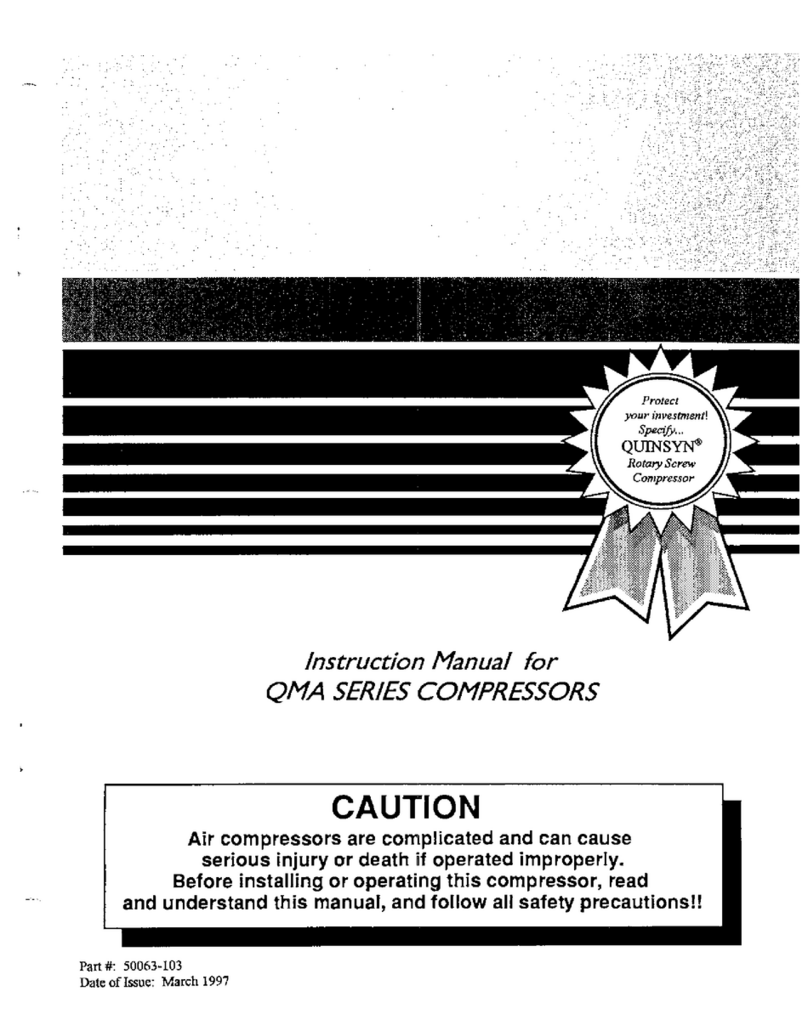
Quincy Compressor
Quincy Compressor QMA Series instruction manual
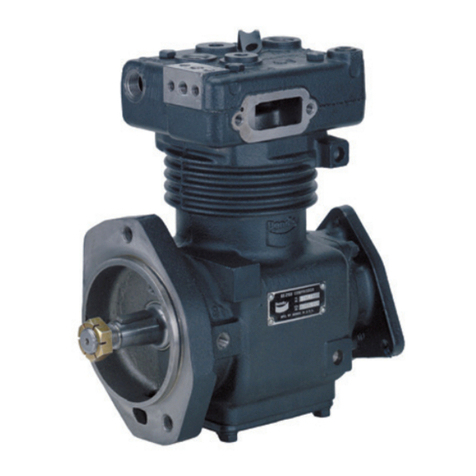
BENDIX
BENDIX BX-2150 quick start guide
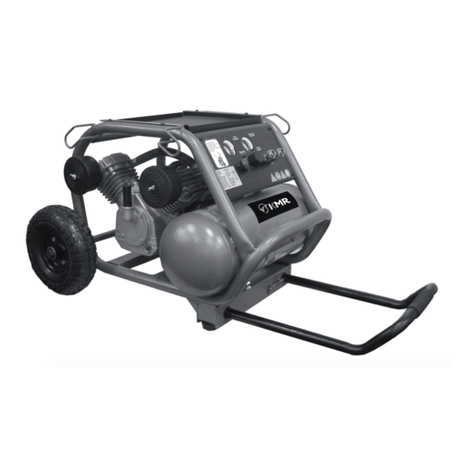
KMR
KMR KV 350-15 operating instructions

Marshalltown Company
Marshalltown Company DUOFLEX HC125A user manual
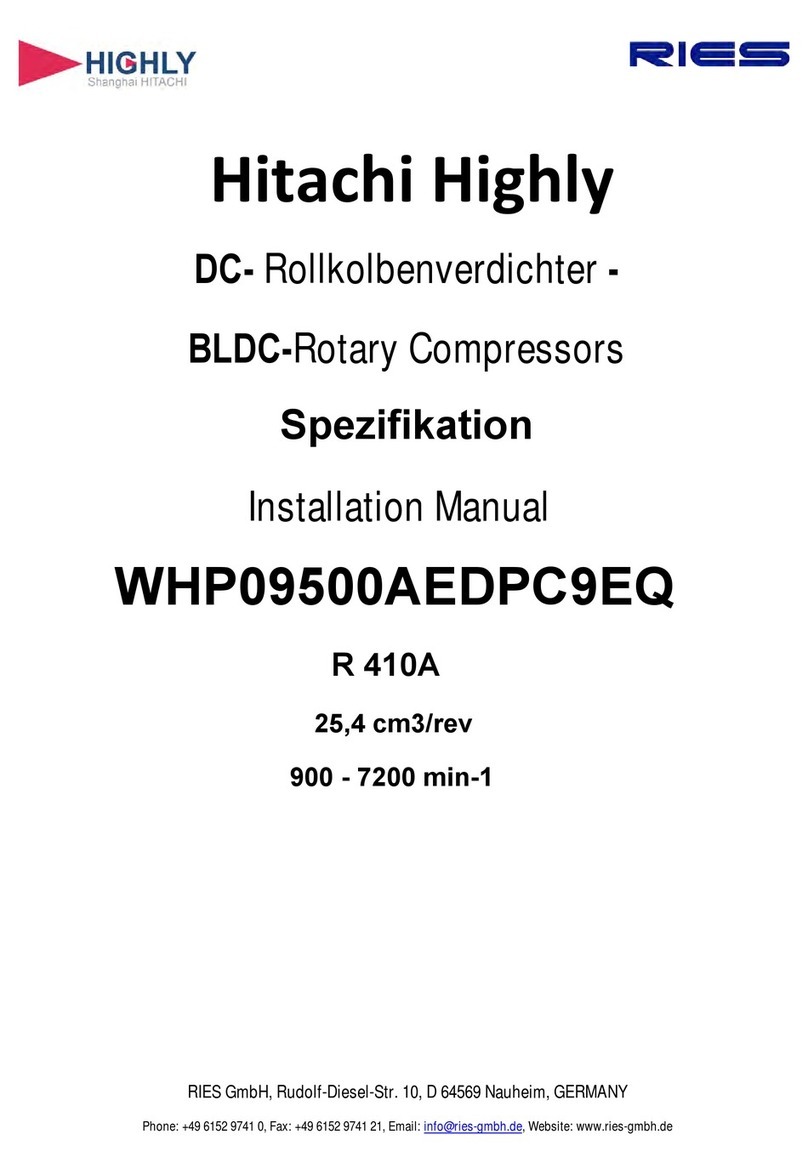
Hitachi
Hitachi WHP09500AEDPC9EQ instruction manual
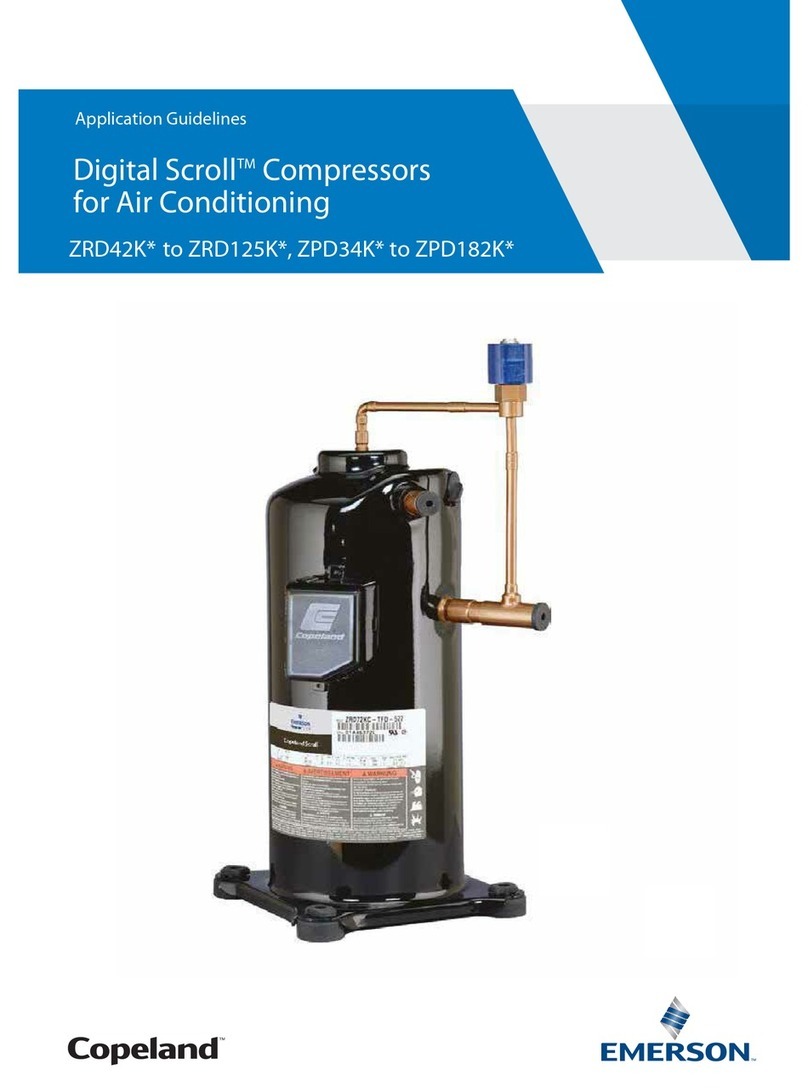
Copeland
Copeland Digital Scroll ZRD42KCE Guidelines
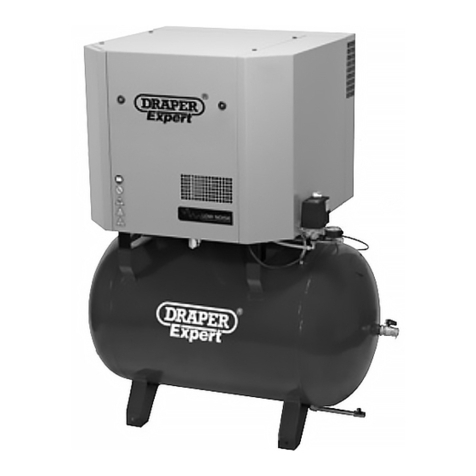
Draper
Draper DA270 instructions

Black & Decker
Black & Decker 9527 instruction manual
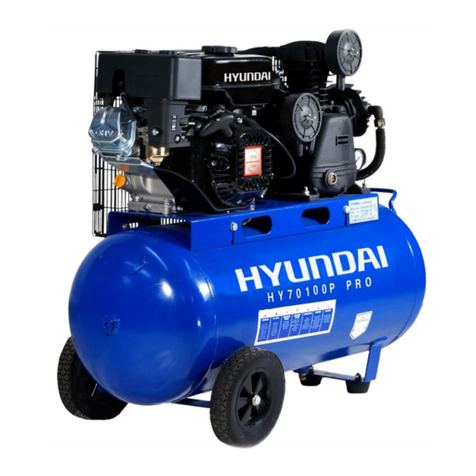
Hyundai
Hyundai HY70100P user manual

Daikin
Daikin DWSC 050 Installation, operation and maintenance manual

Donaldson
Donaldson UFM-T100H manual
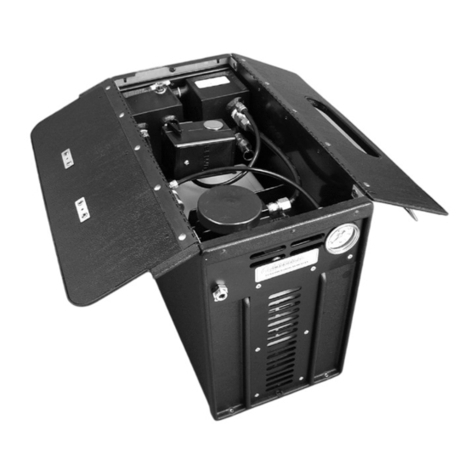
Aseptico
Aseptico AA-74 Installation, operation and maintenance instructions manual
